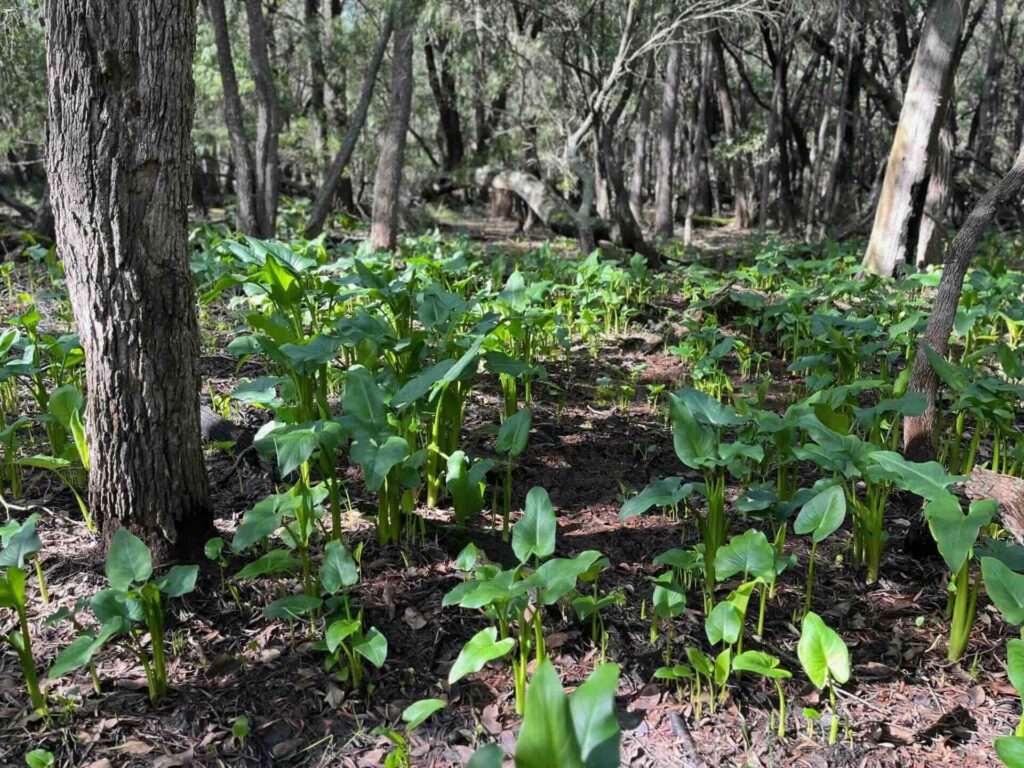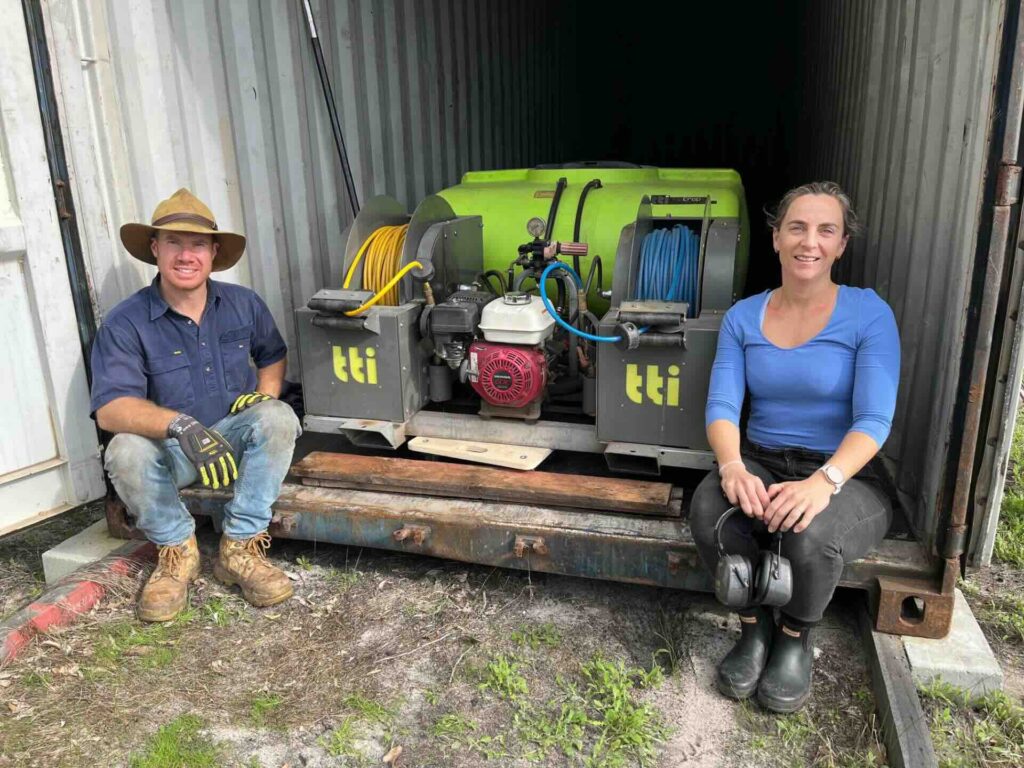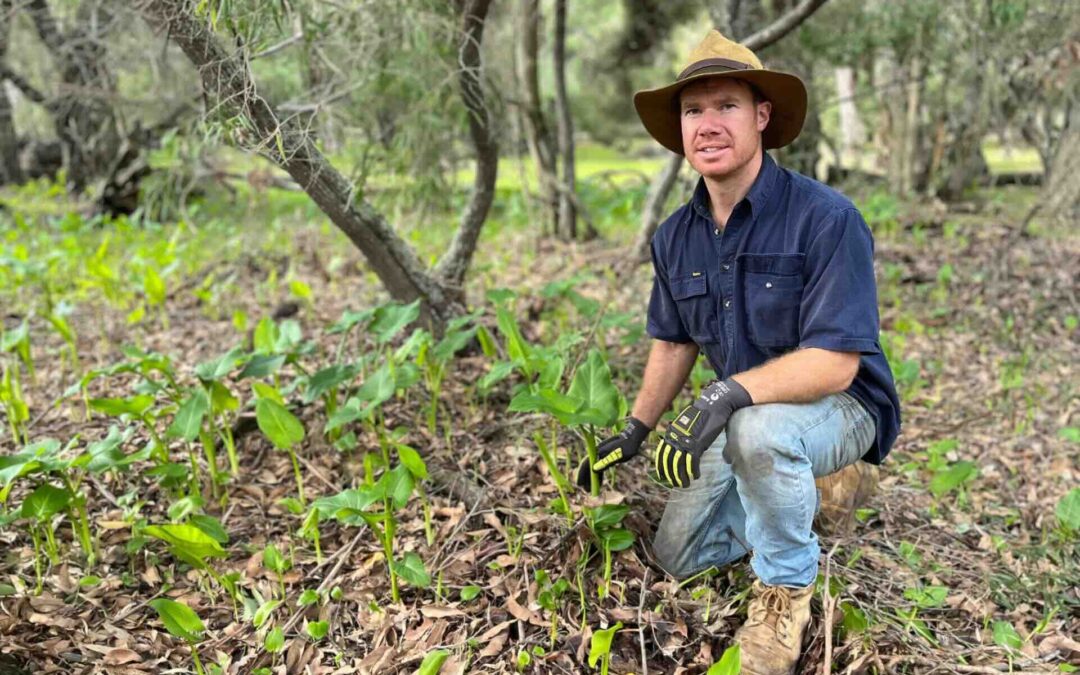If there’s one powerful lesson learned when it comes to controlling arum lilies, it’s that tackling this invasive and damaging environmental weed is a team effort, says Nature Conservation Margaret River Region.
And nowhere is that more apparent than among neighbouring landowners, where neighbours working together can stop the spread of arum lilies in their tracks – but one landholder who doesn’t do arum lily control can let down a whole street or suburb, causing a re-infestation.
In the Jindong area, landholders Cameron and Lindsey Powell are tackling the spread of arum lilies which left unchecked will decimate native bush and ruin habitat for wildlife.
“The arum lily is such a prolific spreader, it’s important that everyone in the community gets on board with removing it and seeing it as the terrible invasive weed it is,” Cameron said. “Otherwise, it will only re-infest previously eradicated areas again.”

Arum lilies ready to be sprayed at Cameron and Lindsey’s property
The couple’s property is a combination of farmland with remnant bushland including some dense, high quality forested areas – a rarity in this locality which has been largely cleared for farming. As well as spraying to control arum lily and spreading native seed to encourage more native plants to return, Cameron has been busy fencing off remnant bushland to protect it from grazing stock.
“Considering the limited amount of remnant bushland in our area, it’s very important to protect what remains,” he said. “This vegetation as we know is so important to our soil health, carbon cycling and water cycles as well as proving habitat for our animals. Which all are so important to maintaining the health and resilience of the land that nourishes us.”
At first, he said the “intense infestation” of arum lily on his property was daunting – but consistency over time has yielded astonishing results. Funding in 2025 through the City of Busselton’s involvement in the “4 Local Government Areas / 1 Weed” program has enabled contractors to focus on protecting more than 60 acres of remnant bushland on their property.
“It’s very easy to become disheartened given the scale of the problem we are dealing with, wondering if we are making a difference or if we will ever have success,” he said. “But great advice from others I have relied on is to be consistent. Don’t expect to transform landscapes in a season or completely remove invasive species overnight. The key is to have a consistent effort at it and over time you will see the results from all the hard work.”
For large properties, Cameron said it can be a good idea to “break things down into small chunks to make it manageable, such as setting grid maps for the areas you want to improve and setting realistic targets for which grids you want to complete in certain timeframes”. He added: “Keeping good records will make this easier, including photographs to see in real time the good results to all your efforts.

Cameron and Lindsey say neighbours working together is vital
“Considering the unique nature of this area, we believe it’s very important we continue to protect this area and to be responsible caretakers of the land to ensure the native vegetation not only remains resilient to external pressures, but can also thrive.”
Nature Conservation Margaret River Region’s hugely successful Arum Lily Blitz coordinates the effort to control arum lilies, with free resources, workshops, herbicide and in some cases cost-sharing for 2000-plus landholders who are signed up, protecting an area spanning 23,000 hectares.

Ben Howell is on the Arum Lily Blitz team
“The decision to support landowners such as Cameron and Lindsey is an easy one considering the investment they have already put in. Just in 2024 alone, they have controlled arum lily over nearly 18 hectares of their property,” says Nature Conservation’s Blitz officer Ben Howell.
“Regardless of the size of your property, we encourage you to register with the Blitz to get the information and support you need”.
Arum lilies are so harmful because they outcompete native plants, reduce habitat and food for wildlife, smother orchids and wildflowers, and swamp native plants in a dense, toxic monoculture.
The wide-leafed plants start appearing from underground tubers in winter and produce a white flower in spring, and large-scale control is only possible with a targeted herbicide.
Now in its 7th year, the Blitz also partners with local and state government and agencies, plus community and volunteer groups to tackle arum lilies. It’s the first coordinated, landscape-scale weed control program of this type in WA, with an ambitious, long term 20-plus year vision to reduce and contain the weed.
“Since transitioning from on-ground contractor to being a part of the Arum Blitz project team, I now have a clear understanding of what makes the program successful,” says Ben. “Teamwork and persistence are key as well as a strategic, co-ordinated approach and long-term vision which is central to Nature Conservation’s mission. Spread the word to your neighbours, be an advocate, and share your arum lily control success stories with us, your friends and family, and even on social media.”
For landholders on larger properties who cannot deal with arum lily infestations on their own, Nature Conservation’s Bush Regeneration Team can be hired to carry out arum control.
The Arum Lily Blitz is funded by the WA Government’s State Natural Resources Management Program. See www.natureconservation.org.au.

